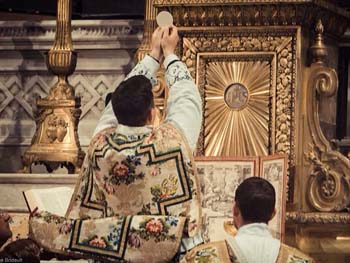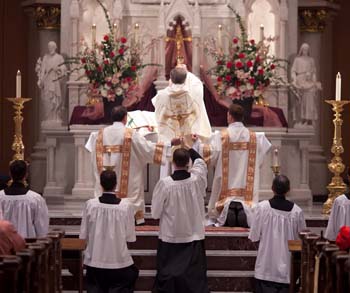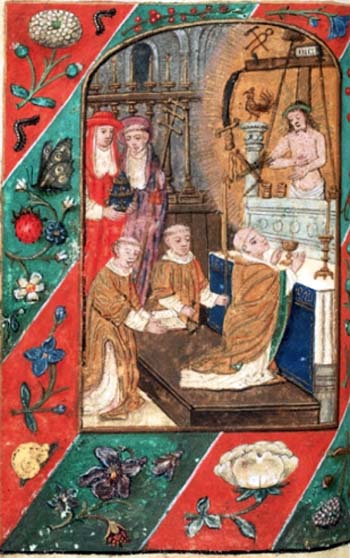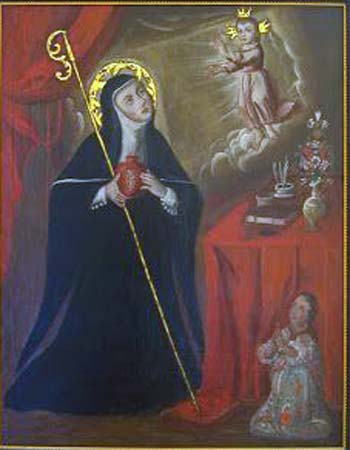Mass of the Faithful:
The Sublime Mystery of the Transubstantiation
In this explanation of the Holy Mass, we have now reached the event on
earth that has infinite value, the very Heart of the Mass, the
Transubstantiation by means of the Consecration of the Host and Wine in
the Chalice, the Holy Eucharist, which is the Body, Blood, Soul and
Divinity of Our Lord Jesus Christ. (1)
What Our Lord did at the Last Supper, the priest does now in His place. He takes the Host in both hands, raises his eyes towards Heaven, bows his head, signs the cross upon the Host and says in low voice the words of Consecration.
The first words "Qui pridie quam pateretur" (who the day before He suffered), were added by Pope Alexander I, the sixth Pope, to recall the Passion that is being renewed on the altar. Then he takes the host between the tips of his thumbs and forefingers and raises it slightly above the corporal. Elevating his eyes to the Crucifix, he says the words "et elevatis oculis in coelum" and then lowers them; at "tibi gratias agens" (giving thanks to Thee), he bows his head.
 The raising of the Host for the faithful to adore
The raising of the Host for the faithful to adoreHaving said these words, the priest rests his forearms upon the altar and inclines his head; holding the Host in the manner described above with both hands, he pronounces the words of Consecration over the large Host and those in the Ciborium with the cover removed. He speaks in a whisper, yet distinctly, his eyes fixed on the host: "HOC EST ENIM CORPUS MEUM, [for this is my Body].
These words must be pronounced distinctly and reverently, and with this, the Transubstantiation occurs and Our Lord Jesus becomes present on the altar.
The moment the words of Consecration are uttered, the priest, his eyes still fixed on the Sacred Host, slowly genuflects on one knee to the floor and adores the Sacred Host. It is the Lord Himself the priest adores.
The bell is rung in both of these genuflections of the priest to announce the sacred Mystery. Then, standing erect, the priest elevates the Host over his head so that the faithful also might see and adore Our Lord present in it. He lowers the Sacred Host slowly and places it with his right hand on the corporal; again he genuflects in adoration.
Henceforth, every time he touches the Host he genuflects both before and after to pay homage to Our Lord. Henceforth also, he will not disjoin the thumb and index finger of each hand until the ablution because these fingers alone, consecrated in a special way at his ordination, have the honor of touching Our Lord. (2)
After the Consecration of the Host into the Body of Our Lord Jesus comes the Consecration of the wine into His Precious Blood:

Having adored the Sacred Host, the priest places his left hand on the base of the chalice and uncovers it with his right hand, placing the pall on the chalice veil or against the altar card. Then, he purifies his fingers over the chalice by rubbing them together to remove any small particles on them.
 The raising of the chalice at the Consecration
The raising of the chalice at the ConsecrationThe priest raises the chalice a bit and immediately lowers it, and, again giving thanks ("tibi gratias agens"), inclines his head to the Blessed Sacrament. Taking the chalice in his left hand and blessing it with his right, he says the "benedixit…"
Next, the words of the Consecration over the wine are pronounced while he holds the chalice a bit raised. With his head inclined he pronounces reverently and with a very low voice the words of Consecration. "Hic est enim Calix Sanguinis Mei, novi et aeterni testamenti: MYSTERIUM FIDEI qui pro vobis et PRO MULTIS effundetur in remissionem peccatorum (for this is the Chalice of My Blood of the new and eternal testament, the MYSTERY OF FAITH (3) which shall be said for you and FOR MANY for the remission of sins). In contrast to the confusion generated by the Novus Ordo Missae, Mysterium Fidei has only one meaning: Transubstantiation. (For more on this topic, see here).
After pronouncing the words of the Consecration of the wine into the Precious Blood, the priest places the chalice on the corporal, genuflects slowly (the bell is rung), saying "haec quotiescumque feceritis in mei memoriam facietis" (as often as you do these things ye shall do them in memory of Me).
What the Church teaches
With these final words, Jesus at the Last Supper ordained the Apostles (including Judas), giving them and in their persons to all priests, power to do what He had just done, to immolate Him. This is a doctrine of Faith defined by the Council of Trent: "If anyone shall say that by the words 'Do this in commemoration of Me' Christ did not constitute the Apostles priests that they and other priests should offer His Body and Blood, let him be anathema' (Sess. XXII Can 2). (4)
And in this same session of the Council of Trent (Chap 11) the Church teaches: "In the Divine Sacrifice which is celebrated in the Mass, that same Christ is contained and immolated in an unbloody manner who once offered himself in a bloody manner on the altar of the Cross". (5)
 A medieval manuscript expressing lively faith in Christ's presence on the altar after the Consecration
A medieval manuscript expressing lively faith in Christ's presence on the altar after the ConsecrationAt both the elevations of the Host and Chalice, the acolyte raised the chasuble of the priest slightly with his left hand, symbolic of we the faithful present raising our hearts to the Holy Eucharist.
When the Sacred Body in the Host of Our Lord and the Precious Blood in the Chalice are elevated, the faithful should look at them adoringly and only afterwards bow their heads in adoration. Keeping the head bowed low during the Elevations is almost a universal custom among the faithful in the pews. This practice, while originating in good will, is not praiseworthy.
Many are under the impression that it is wrong for us, unworthy men, to gaze at our Eucharistic God. This is an unhappy remnant of the age of Jansenism! To counter this wrong attitude, Pope St. Pius X granted an indulgence of seven years and seven quarantines to all who gaze in adoration at the elevations and say in silence "Dominus meus et Deus meus" (my Lord and my God), the words of doubting St. Thomas to Our Lord. (6)
To those who make this invocation daily, St. Pius X granted a plenary indulgence once a week provided they receive Holy Communion subject to the usual conditions. The invocation should not be said aloud.
 St. Gertrude received many privileges from Christ, including seeing him present in the Host on the altar
St. Gertrude received many privileges from Christ, including seeing him present in the Host on the altarOur Lord revealed to St. Mechtilde, St. Gertrude's sister: "I alone know and perfectly understand what this offering is that I daily make of Myself for the salvation of the faithful. It surpasses the comprehension of the Cherubim and Seraphim and all the heavenly hosts." (8)
St. Colette, who had great devotion to the Holy Mass, told her confessor these words regarding the Consecration: "When your Reverence elevated the Sacred Host, I beheld Christ on the Cross; the Blood flowing from His Precious Wounds. At the same time I heard Him say to the Eternal Father, 'Look upon My Wounds, look upon the Blood that I shed, consider My sufferings, consider My death. All this I endured to save sinners.'" (9)
One single drop of the Precious Blood is worth more than oceans of the blood of martyrs. In her Mystical City of God, Venerable Mary of Agreda states: "The drops of His Precious Blood shed at the Circumcision sufficed for the salvation of mankind, but the Heavenly Father deemed that He shed every drop of His Precious Blood when Longinus pierced His Sacred Heart."
During Holy Mass we should beseech the Heavenly Mediatrix, the Blessed Virgin Mary, to offer our prayers for the Church, for the conversion of sinners, for the poor souls in Purgatory and for other various needs. We may be assured that we shall receive special graces by this practice.
De defectibus
I close this article with a note of vital importance to priests saying the Tridentine Mass, pointing to the document De defectibus issued by the Council of Trent (1545-1563). This document was ratified as a Papal Bull by Pope St. Pius V in 1570 in Quo primum tempore.
That Papal Bull discusses the defects that occur in the celebration of Mass and reaffirms the grievous sin committed by deliberate omissions, changes or improper recitation made in the Form of the Sacrament at the Consecration of the Host and Wine into the Body, Blood, Soul and Divinity of Our Lord Jesus Christ.
Sadly, De defectibus is little known by traditional priests because it is rarely taught in the seminaries or studied by the priests, even though it is readily available today. Therefore, aberrations in saying the consecratory formulae are not rare today.
Since the Holy Mass is of such surpassing excellence that not even one of the highest Angels can praise it aright, it is only meet and just that the priest should follow the rubrics of the Consecration with the greatest of care.
To be continued
- The Institution of the Holy Eucharist was given in the Gospels of Matt. 26:26-28; Mark 14:22-24; Luke 22:19; 1 Corinthians 11:23-26. Holy Church begs for the sublime wonder which Our Lord performed at the Last Supper.
- Dom Prosper Guéranger, Explanation of the Holy Mass, 1st ed. 1885, rep. Loreto Publications, 2007, pp. 131.
- The great importance of MYSTERIUM FIDEI is detailed in another article here.
- Martin von Cochem, Explanation of the Holy Sacrifice of the Mass, NY: Benzinger Bros., 1896, pp. 16-17.
- Ibid., p. 226.
- The indulgence is pointed out in the St. Andrew's Missal.
- Cochem, Explanation of the Holy Sacrifice, p. 340.
- Ibid., p. 44.
- Ibid., p. 124.

Alleluia!
ReplyDeleteGREAT ARTICLE ONCE AGAIN FROM DR REMI
ReplyDeleteThis was very helpful, thank you
ReplyDelete:)
Delete
ReplyDeleteAnd Transhumanism is the Satanic version of Transubstantiation.
good to see you cybro, hope to see u daily
DeleteSt. Pio said the earth could survive without the sun but it could not without the Mass.
ReplyDeletePray for holy priests and more opportunities to the Sacraments
William K
ReplyDeleteWe truly believed that the host and the wine change into the Body and Blood of Jesus after the consecration.
The Latin Mass is the only way to get close to God with more faithful people attend the Mass and with genuine devotion. Please let us be closer to God by bringing back the real Mass as Jesus founded.
ReplyDeleteLaurie B
Dr. Remi once again doing a superb job!
ReplyDeleteGreat article should be posted to the supposed Popes twitter account lol.
ReplyDelete